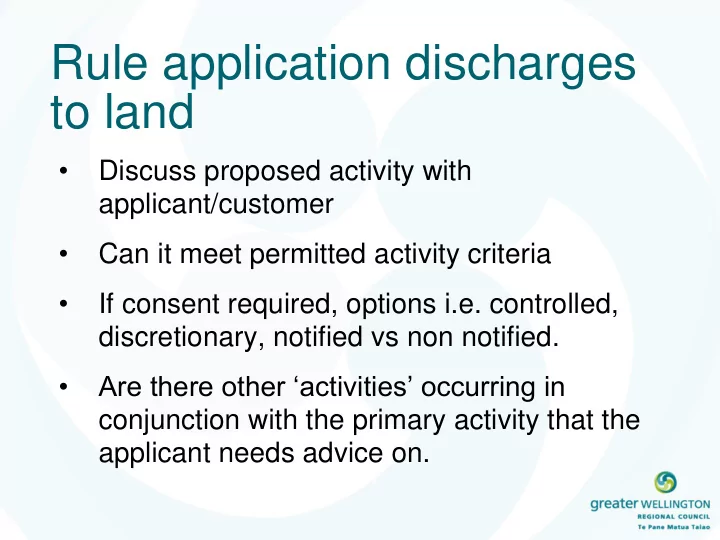

Rule application discharges to land • Discuss proposed activity with applicant/customer • Can it meet permitted activity criteria • If consent required, options i.e. controlled, discretionary, notified vs non notified. • Are there other ‘activities’ occurring in conjunction with the primary activity that the applicant needs advice on.
Permitted Activities Pros - Cons • Enabling for the person undertaking activity without undue red tape • Individually activities generally low risk to environment as long as conditions complied with • Cumulatively activities can have more than minor effects on environment especially if conditions of rule not met
Permitted Activities Pros – Cons cont • No compliance undertaken on permitted activities. Little or no knowledge about where they are being undertaken • Rely on public reporting non-compliance • Little face to face contact/education with the people undertaking the activity
Contractor told us they were disposing of Cleanfill – included asbestos and rubbish you can see here
Permitted Activity Examples – Farm dumps and offal pits
Operative Rule 9 Proposed R89 Suggested in Sn42A report Generated on property itself Same Same 20m away from surface water 50m from surface water, CMA, As proposed in R89 gully, bore used for potable water supply, boundary No hazardous substances Same Same 1m above water table 0.6m above water table As Proposed in R89 No windblown litter Requirement removed Requirement removed Ground rehabilitated within 6 Same Same months of farm dump becoming ‘full’ • No burning Offal or dead animal matter • Not in community drinking removed, therefore farm dump water supply area can also be offal pit. • No odour beyond boundary All other requirements same as • Does not contain wastewater, Proposed R89 offal or dead animal matter • Size and location recorded • Not exceed 50m 3 Only on a property: As Proposed in R89 Over 20ha; or In silty or clay soils; or where no kerbside collection Or more than 20km of a transfer station
Groundwater
Offal Pits • Definition of Offal pit = hole excavated – if using farm dump to dispose of carcases/dead animal matter, no requirements for it to be below ground • Proposed removal of the word ‘gully’ will it enable farmers to dump carcasses/dead animal matter down the nearest gully? • Meaning of surface water excludes ephemeral flow paths which I believe most gullies are.
Application of Agricultural effluent rules as proposed in Section 42A report
Collected Animal Effluent onto or into land • Majority of proposed R83 same or similar outcome to operative rule 13 • Addition of requirements around storage to enable deferred irrigation and sealing of that storage • Discharges within a drinking water supply protection area bumped into discretionary activity
Changes proposed in Section 42A report • Meaning of animal effluent proposed to exclude solid animal waste • ‘spreading’ solid animal waste will then sit under application of compost R85 (Permitted) • ‘storage’ of solid animal waste will sit under R90 where it will be required to be stored on an impermeable surface (Permitted) • Will no longer know where the solid waste is being spread and no monitoring will occur • Solid animal waste definition proposed to exclude dead animals or animal parts
Large stock pile of screw press Decomposing pig carcass amongst screw solids with ponding leachate not press solids on sealed surface
Sewage both OSWW and municipal. Industrial discharges • Proposed rules similar to operative rules with the exception of R79. • Permitted activities tweaked to reflect more current standards (AS/NZS) • Discharges in Community drinking water supply catchment default to discretionary
Sewage both OSWW and municipal. Industrial discharges • R79 created as TA’s wanted a controlled activity for discharge to land of municipal sewage. CDC application example of discretionary activity being easier to obtain. • Wording of R79 didn’t include the word ‘municipal’, any activities discharging ‘wastewater’ were trying to use R79 and put them in worse position than a discretionary consent process.
Sewage both OSWW and municipal. Industrial discharges • Proposal in Section 42A to reverse rule R79 to exclude municipal wastewater and create controlled activity for small to medium industrial discharges. • Affords some protection to agricultural land with requirements around not containing hazardous substances or substances likely to cause infectious disease in humans or other animals or contain human sewage.
Recommend
More recommend